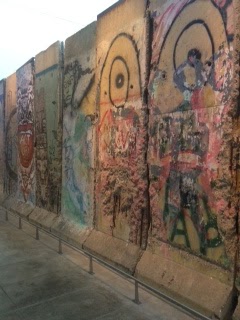On a Friday near the end of January, our group had tickets to embark on our first study tour by ourselves (since Katy was out interviewing students for this experience in the summer-- yes… already). We embarked for the Newseum in the morning, meeting up together in the massive studio-style lobby. I entered college as a journalism major with an affinity for writing since I was able to read, so this stop was especially close to my heart. Public Affairs has allowed me to combine my love of reading, writing, and politics into one, and my internship with in the Press Office this semester at the Department of Education has developed that coalescence even more.
 We split up into smaller groups (somehow 8 people can really disperse themselves), and myself and a few other fellows ended up at the Berlin Wall. Yes-- (a piece of) the real one. The wall was surrounded by maps and stories of Germany’s division. One side of the wall was covered almost completely in graffiti. From art to expressions of anger, the democratic West Berliners documented the time through artistic expression. The east side was completely bare, save for a few cracks. Seeing the real wall, along with the watch tower used to take down anyone trying to escape was a stark reminder of our freedom.
We split up into smaller groups (somehow 8 people can really disperse themselves), and myself and a few other fellows ended up at the Berlin Wall. Yes-- (a piece of) the real one. The wall was surrounded by maps and stories of Germany’s division. One side of the wall was covered almost completely in graffiti. From art to expressions of anger, the democratic West Berliners documented the time through artistic expression. The east side was completely bare, save for a few cracks. Seeing the real wall, along with the watch tower used to take down anyone trying to escape was a stark reminder of our freedom.
The Pulitzer Prize Photo wall was also a noteworthy exhibit. It was powerful. We could each probably write an entire blog post for each photo-- it was almost like seeing the past 100 years, around the world fly past you. There were photos anywhere from an American suburb to the deserts of a third world country. The emotions were both expected and surprising. We saw tears among riches and laughter among ruins. A clip running in the center of the room featured one of the winners discussing a photo and the story behind it. But what was caught my interest was the fact that he was not talking about his own photo, but a colleague, Kevin Carter. Kevin grew up in a whites-only neighborhood in a religious family, sheltered from the world of injustice in the civil rights movement that surrounded him. Carter left the army after seeing the horrors of the Church Street Bombing to become a photographer. While photographing in South Sudan, Kevin was preparing for a shot of a small, starving child struggling to reach a local food center. As he focused the shot, a vulture swooped behind the child, watching and waiting. He snapped the shot. This portrait of death and absence of dignity turned into a Pulitzer Prize for Feature Photography in 1993 and sparked the attention of many wondering the fate of the girl. Three months later, Carter committed suicide, citing his memories of killings and pain as reasoning.
“Th’ newspaper… comforts th’ afflicted, afflicts th’ comfortable.”
-Finley Peter Dunne, 1902
I could write blog posts about this museum every week until I return to Columbus. Beyond the Berlin Wall and photo gallery we saw many pieces of history, from a timeline of the First Dogs, to a chilling 9/11 display, recalling the events of the first major historical event that our group could remember clearly in our lifetime. The Newseum was similar to the myriad of museums in the District as it showcased the world at both it’s highest and lowest points. But what made it extraordinary was that it revealed these events as they were told, in real time, and without limitations, as the press should.
“People have a need to know. Journalists have a right to tell.
Finding the facts can be difficult. Reporting the story can be dangerous.
Freedom includes the right to be outrageous. Responsibility includes the duty to be fair.



No comments:
Post a Comment